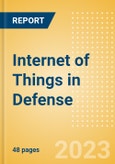The applications of IoT in defense are wide-ranging, and the industry’s heavyweights are all involved. Applications of IoT in defense include health monitoring, augmented reality (AR) remote training, gaining situational awareness using drones, vehicle management, target recognition, and many more. Smart sensors can be used on military equipment to give data on their health and whether maintenance is needed. This helps reduce operating costs and downtime for military equipment as the sensor can predict when a breakdown is imminent. However, this proliferation has also brought up concerns. Interoperability and increased information sharing make cybersecurity more of a threat, as there are increased access points for hackers, and the interconnected nature of IoT means any attack could have devastating consequences.
IoT can connect assets and make them work together as a force multiplier, giving forces a strategic advantage as conflicts become increasingly data-driven. Real-time information sharing between branches of the military is crucial due to the high stakes involved. It can also increase the efficiency of the observe, orient, decide, act (OODA) loop. Decision-makers will increasingly have access to more and better information aggregated in a digestible format as IoT technology improves. This means that they will have more situational awareness and greater insight into potential threats, giving them an advantage over militaries not pursuing this type of technology.
Key Highlights
- Studies of emerging technological trends and their broader impact on the defense market.
- Analysis of the various IoT related programs and projects currently under development, as well as the impact of emerging technologies such as artificial intelligence on the future outlook of the military IoT theme.
Who Should Buy
- Our thematic research product, supported by our thematic engine, is aimed at senior (C-Suite) executives in the corporate world, decision makers, and institutional investors.
- Corporations: Helps CEOs, CTOs, and other senior executives of companies understand this key theme, the competitive environment, and the market opportunities.
- Investors: Helps fund managers and other major investors focus on investment opportunities in defense and understand the market around military IoT
Scope
- The key defense challenges that forces and defense sector suppliers face are covered.
- The investment opportunities for armed forces, suppliers, and institutional investors, across the whole military IoT value chain are covered.
- Highlights from the development programs currently being undertaken by various military organizations and defense companies.
Reasons to Buy
- Determine potential investment companies based on trend analysis and market projections.
- Gaining an understanding of the market challenges and opportunities surrounding the military IoT theme.
- Understanding how spending on military IoT and related segments will fit into the overall market and which spending areas are being prioritized.
Table of Contents
- Executive summary
- Players
- Defense Challenges
- The impact of IoT on defense
- How IoT can help address the challenge of data deluge
- How IoT can help address the challenge of deployed environment conditions
- How IoT can help address the challenge of digitalization
- How IoT can help address the challenge of training and education
- How IoT can help address the challenge of manned-unmanned teaming
- Case studies
- Market size & growth forecasts
- Signals
- Mergers and acquisitions
- Patent trends
- Company filing trends
- Hiring trends
- IoT Value Chain
- Physical layer
- Connected things
- Cameras and lenses
- Sensors and microcontrollers
- Microprocessors
- Connectivity layer
- Edge infrastructure
- Cloud infrastructure
- Networking equipment
- Telecom networks
- Data layer
- Data integration
- Data aggregation
- Data processing
- Data storage
- Data validation
- Data governance and security
- App layer
- Apps
- Platforms
- Services layer
- Integration services
- Consulting services
- Companies
- Leading IoT adopters in defense
- Specialist IoT adopters in defense
- Sector Scorecards
- Aerospace, defense and security scorecard
- Glossary
- Further reading
- Thematic Research methodology
- About the Publisher
- Contact the Publisher
- Defense challenges
- Mergers, acquisitions
- Leading IoT adopters in defense
- Specialist IoT vendors in defense
- Glossary
- Further Reading
- Leading players in the IoT theme in the defense sector
- IoT impact matrix
- Global enterprise IoT market revenue ($ trillion), 2019-27
- IoT in defense-related patents by company, 2020-2023
- IoT in defense-related company filing trends by company, 2016-2023
- IoT in defense-related hiring trends by volume, 2020-2023
- IoT value chain
- The physical layer of the IoT value chain
- The connectivity layer of the IoT value chain
- The data layer of the IoT value chain
- The app layer of the IoT value chain
- The services layer of the IoT value chain
- Sector scorecard - Companies
- Sector scorecard - Thematic
- Sector scorecard - Valuation
- Sector scorecard - Risk
Companies Mentioned (Partial List)
A selection of companies mentioned in this report includes, but is not limited to:
- Accenture
- Airbus
- Anduril
- AT&T
- Atos
- BAE Systems
- Black River Systems
- Boeing
- DXC Technology
- Elbit Systems
- Fujitsu
- General Dynamics
- Getac
- Honeywell
- IBM
- L3Harris
- Leidos
- Leonardo
- Lockheed Martin
- Microsoft
- Northrop Grumman
- Palantir
- Qinetiq
- Rafael
- Renesas
- Rostec
- RTX
- Shield AI
- Sopra Steria
- Systel
- Teledyne
- Thales








